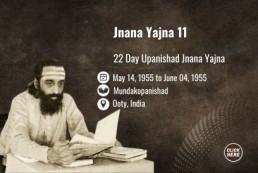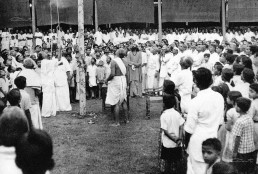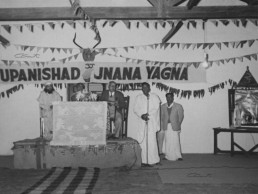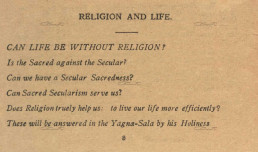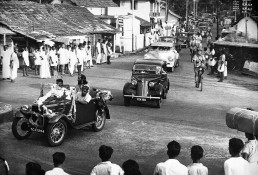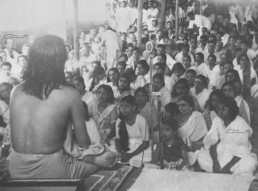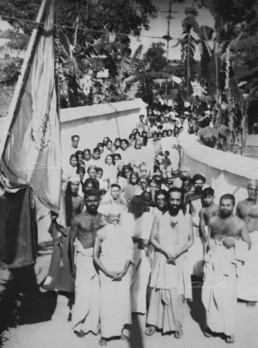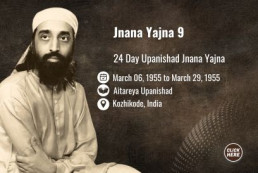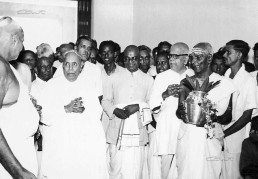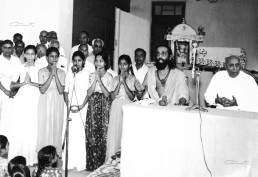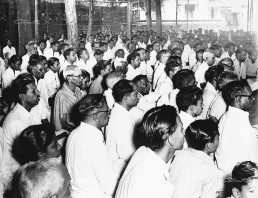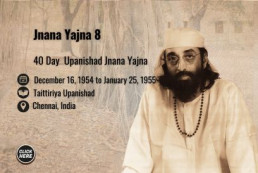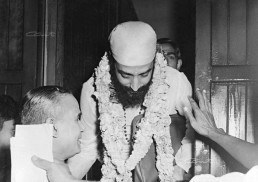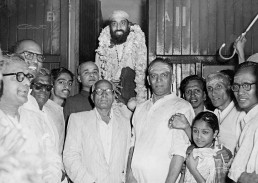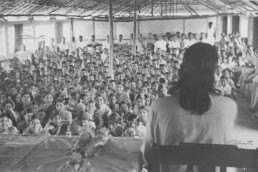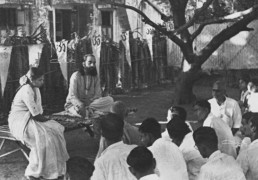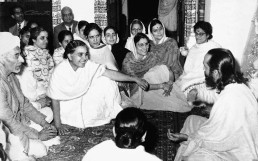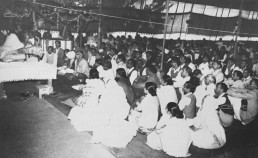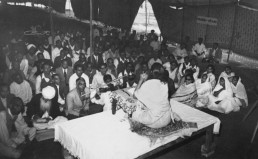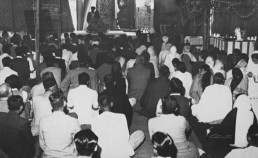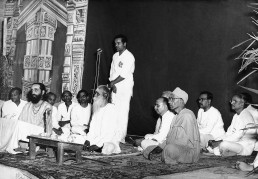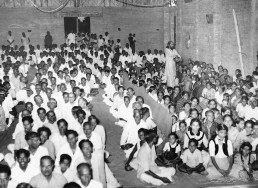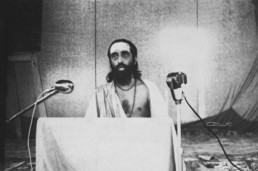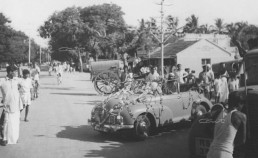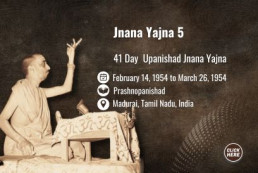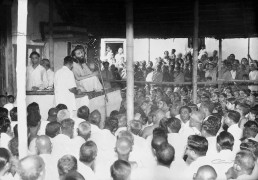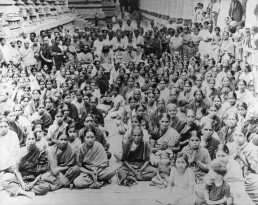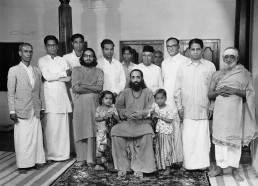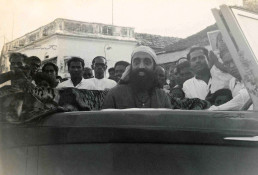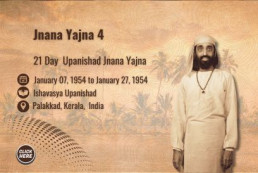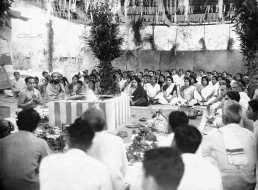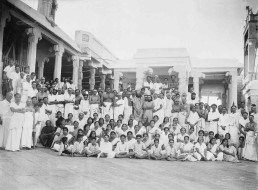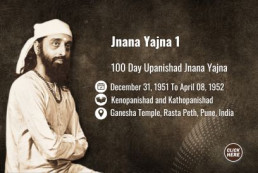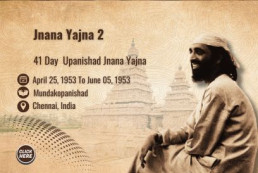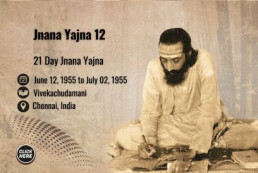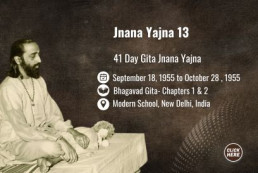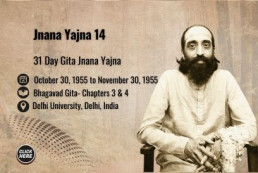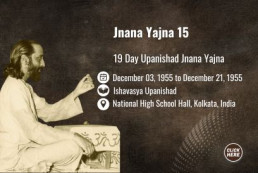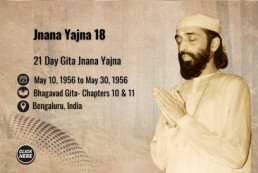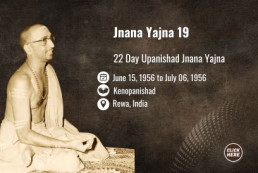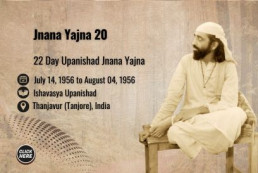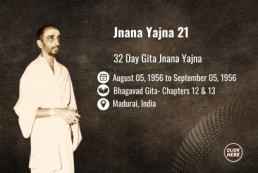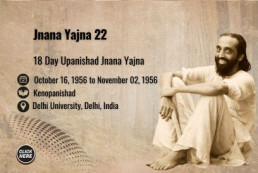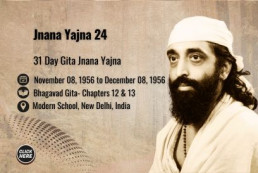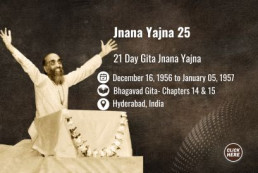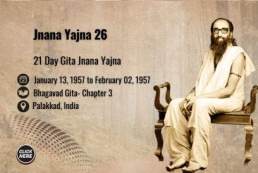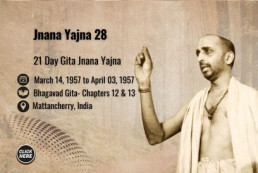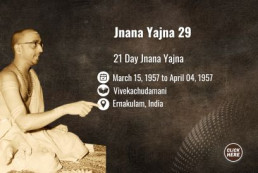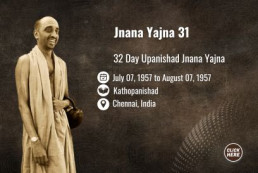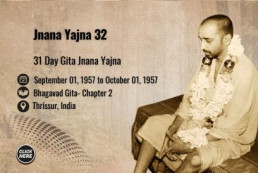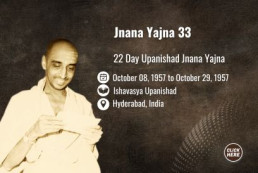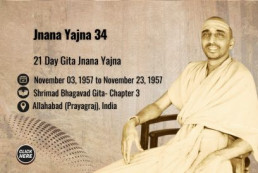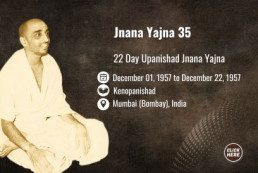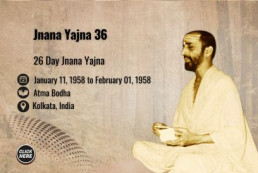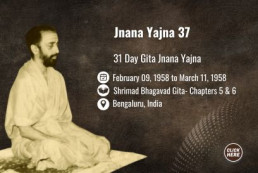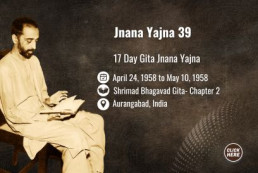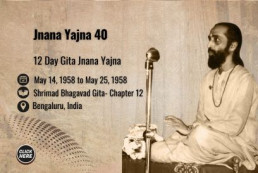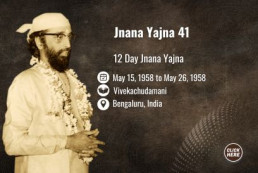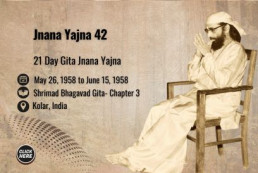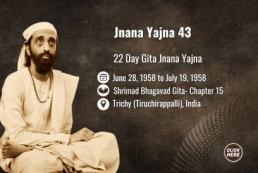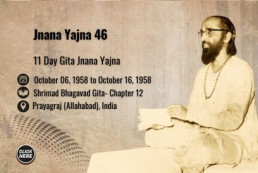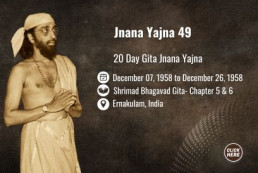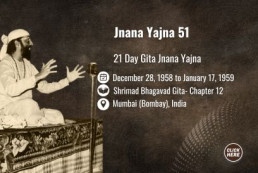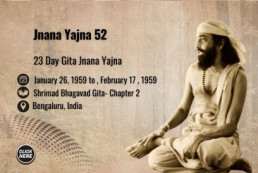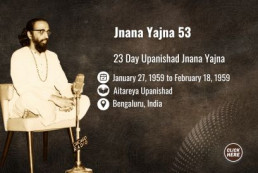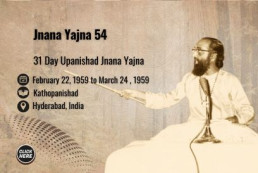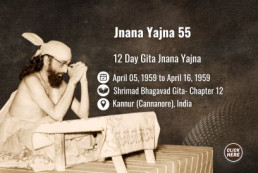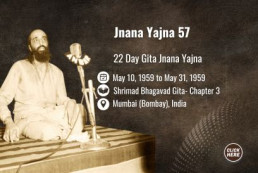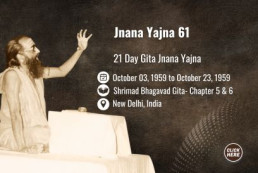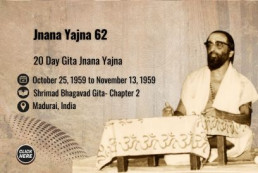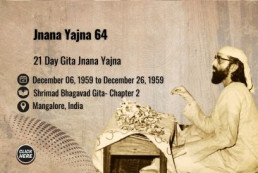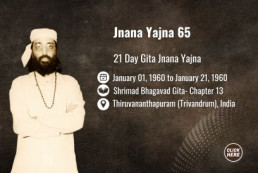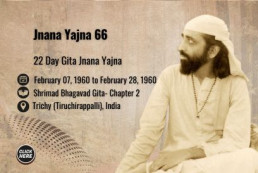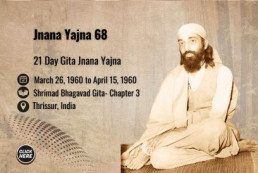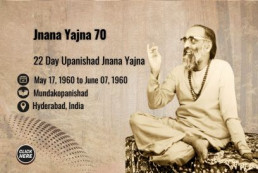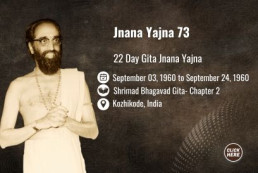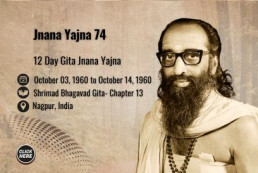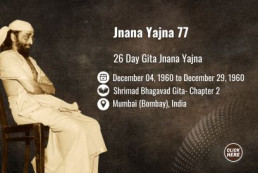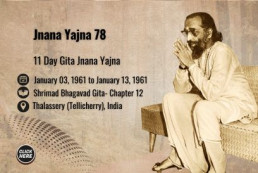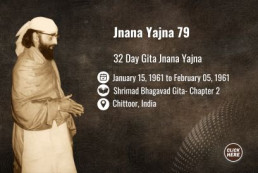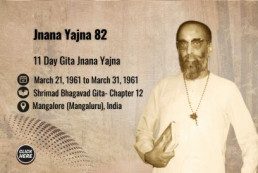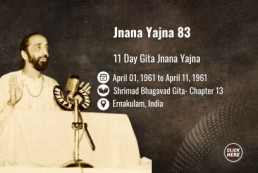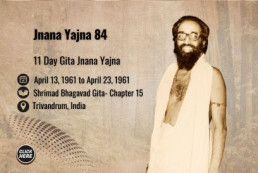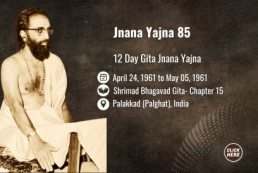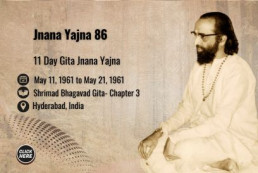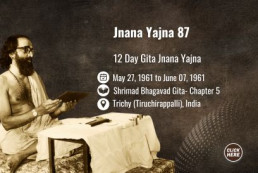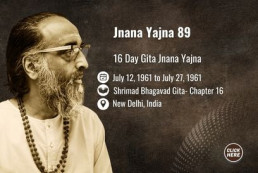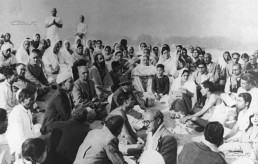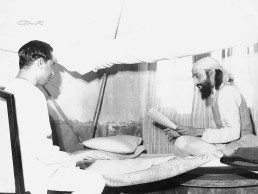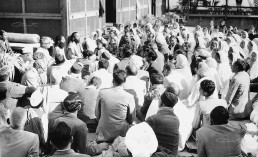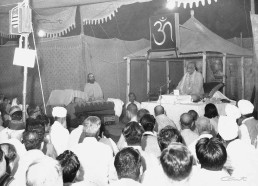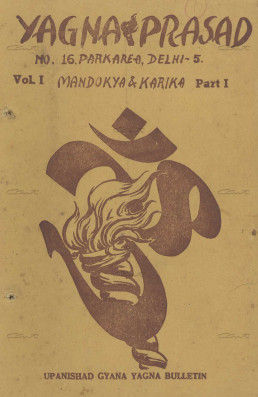Jnana Yajna 11

Jnana Yajna 11

Year & Dates:
May 14, 1955 to June 04, 1955

Yajna Topic:
Mundakopanishad

Place:
Ooty, India.
“What is That, my Lord, knowing which all these become known?” enquired the great householder Shaunaka after he respectfully approached Sage Angiras. So opens Mundakopanishad. Describing and detailing the thought-provoking Upanishad in his 11th Jnana Yajna, Pujya Gurudev Swami Chinmayananda prompted the audience in Ooty to reflect and evolve. An important outcome by the end of this 21-day yajna was the publication of the “Mundakopanishad” book which compiled all of Pujya Gurudev’s commentary taught during both the second Jnana Yajna in Chennai and the 11th yajna in Ooty. In His introduction to the book, Pujya Gurudev wrote: “The very concept of Jnana Yajna was conceived by me in a moment of love, and these Yajnas were worked out in an atmosphere of love depending upon love, demanding only love, and the workers working merely for love.”
Yajnas in Lasting Pages
Throughout the ten Jnana Yajnas that had awakened people to the glory of their Vedic heritage, Pujya Gurudev had envisioned with loving foresight that the word should spread far and wide. Hence, He systematized the reflections of every Yajna in the ‘Yajna Prasad” booklets that were distributed first free and then at nominal cost to thousands of seekers. It is an incredible feat how Pujya Gurudev would spend countless hours to dictate and record the scriptural teachings after His discourses for the world to keep reaping the benefits of those priceless reflections. The earliest ‘Yagna Prasad’ booklets sowed the seeds for his prolific writing that gave rise to “Chinmaya Publications.” To keep the spark of Awareness alive in all our pursuits in life, Pujya Gurudev gifted us with the precious pages, year after year. Like the famous imagery in Mundakopanishad, the sparks from the Vedantic fire that He kindled still glow in the pages of His Prasad booklets, books, and all His words.
In Admiration
Karthiayini G Nayar who was blessed to listen to Pujya Gurudev’s discourses in Ooty shares these impressions:
Listening to Swamiji speak, one would feel self reliant, self confident, bold enough to face any crisis knowing that everything in the world is ephemeral. An knowing what is good company or Satsang, one would not enjoy the company of ordinary people where the conversation is often about irrelevant and flimsy matters
Photo Gallery
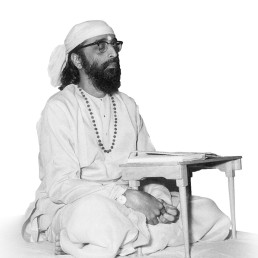
“Think,” Says Pujya Gurudev
Let us try an example: A driver at the steering-wheel, while driving, cannot be run over the same car.The moment the driver leaves his seat and rushes to the front of the car, since the car has no motion of its own, it stop and so cannot knock him down and run over him! Similarly, the Atman, the dynamic power behind the mind that vitalises the mind- that makes it possible for the mind to grasp things- cannot be grasped independently by the mind. Should the mind grasp the Reality, it should stand apart from the object it so grasp: and the moment the mind divorces itself from its connections with the Atman, it becomes a dead inert stuff which cannot grasp any idea anymore. Hence we say that the Supreme is ungraspable.
From Mundakopanishad Book
The Word ‘diligently’ (niyatam) is very pregnant. It does not merely suggest a faithful and blind performance, but insists upon a regular practice which is continuous, intelligent, fresh and cheerful. Rituals followed as a routine lose all their potency.
A routine in itself cannot constructively re-create a developed human personality. It is only a deliberate intelligent training of the head and heart of an individual, grained through diligent abhyas that can bring about this desired effect. A dull habit, or an inert routine pursued under the blind force of a dead faith is ineffectual and quite undesirable as a measure in the spiritual revival of an individual.
Rituals in themselves cannot and will not lead a seeker to his goal. An act, however noble, cannot, in its result, procure the Eternal, the act being itself a finite one.
From Mundakopanishad Book
The Light beyond light!
Explore the mystical realm of Mundakopanishad as we decode its enlightening verse that challenges our understanding of light, fire, and divinity. Witness the symbolic significance of aarati and the flame, realizing how our attempts to see the divine mirror our journey from the material to the infinite.
Jnana Yajna 10
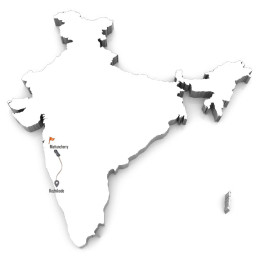
Jnana Yajna 10

Year & Dates:
April 14, 1955 to May 04, 1955

Yajna Topic:
Kenopanishad

Place:
Mattancherry, India.
In the diverse crowd, the youth outnumbered the old. They came eagerly, forgetting for 21 days, the thrills of their usual pastimes like sports, cinema, or fun get-togethers. Women of all ages hurried to the front rows, knowing that they too belonged in the Vedantic discussions. This was another cornerstone achievement of Pujya Gurudev – to open the portals of Vedanta to the young and old, to women as much as men. From a varied audience of 300 seated on the sand-floored yajnashala on the inaugural day to 1500 spilling over extensions added on the sides in a week, the scene was getting familiar.
A Charismatic, Universal Appeal
The trend set in the very first yajna in Pune was becoming the norm by the tenth Jnana Yajna in Mattancherry, Kerala. Hearing Pujya Gurudev Swami Chinmayananda reintroduce the ancient truths of Hinduism in a relatable, catchy way, the audience understood the great relevance of scriptures in daily life. From the scholars to the simple-minded, each one resonated with Pujya Gurudev’s way of expression. The scholars were astounded at His breadth of scriptural knowledge. The scientists, businessmen, lawyers, and administrators were surprised at the way He kept abreast of latest advancements, economic, and societal changes. The women, whether at home or office, were convinced that Pujya Gurudev was their cherished spokesperson. The youth were captivated by His charisma, his fearless, sharp wit, and His approachability. The old were relieved that Hinduism had found its commanding voice. His striking similes, detailed examples, dramatic stories, and animated jokes – His every expression with undiluted Vedanta touched hearts and transformed lives. He encouraged, instructed, comforted, and uplifted – In Mattancherry too, He was the center of attraction, as He let the verses of Kenopanishad flow in and through the receptive minds of His adoring audience.
In Admiration
Mrs. Janaki Menon’s impressions of the Mattancherry Yajna:
This 21 days Yajna was a milestone in the spiritual progress and awakening of the town. People who once prided themselves upon their atheistic and materialistic beliefs had suddenly become ardent supporters of Swamiji and his methods. Unlike the teachers of the old, Chinmaya examines the Vedas and the Upanishads, which form the foundation of Hinduism, in the cold light of scientific reasoning, and with dispassionate and critical analysis their validity is tested.
Photo Gallery

“Think,” Says Pujya Gurudev
A salt-doll tied to a string and dipped into the ocean will not come back when pulled up to report the depth!! The doll gets melted into the very form of the ocean; the salt-doll was ever the ocean; it was born from the ocean. But it had for a period an identity of its own and a form. But once having reached the bosom of its own “Nature” and remaining there for a time, it becomes the very ocean that it Eternally was!!
That is, the doll-ego which exists as a superimposition upon Truth, Pure Salt, assumes for a time certain false forms and names. But when actually at last it entered the mass of its own nature it got merged there with its own svaroopa.
From Kenopanishad Yajna Prasad, p. 153, 154
All efforts in meditation are only for the beginner; a swimmer drowns and gulps down water only during the first days of his learning himself to float in water! Having mastered his art, a rope dancer is bored to repeat night after night his acrobatic and feats of balance although he must have had his own falls and bruises, thrills and joys, during his attempts at mastering his art. Similarly, a meditator may have a struggle to keep his mind in balance and in peace in his early attempts but ere long, as he gains more and more confidence and balance, he shall with a joyous ease float into himself, and there, in an effortless effort meet face to face with the One, his own self.
From Kenopanishad Yajna Prasad, p. 195
Chant for an Alert, Vigilant Mind
Unlock the secrets of success with the powerful chant of sahanaavavatu. This enlightening excerpt from Kenopanishad talk series from Houston, 1981 explores the deep meaning behind the invocation verse or shaanti paatha, guiding both the teacher and student toward an alert and vigilant state of mind. Join us on this spiritual quest for knowledge, wisdom, and ultimate success.
Jnana Yajna 9
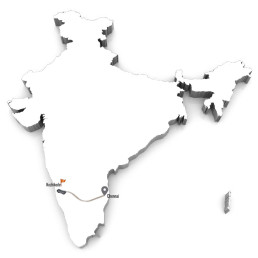
Jnana Yajna 9

Year & Dates:
March 6, 1955 to March 29, 1955

Yajna Topics:
Aitareya Upanishad

Place:
Kozhikode, India.
In Kozhikode, during the 21-day long ninth yajna, Pujya Gurudev extolled the glory of Aitareya Upanishad, bringing out the essence that “Consciousness is Brahman.” People from all walks of life were shown the grand vision of a spiritual unity above all visible differences.
Notable was the discipline in the growing audience who rushed out of their homes to be in perfect time every evening for Pujya Gurudev’s masterly presentation of the thought-provoking scripture. The punctuality and discipline that Pujya Gurudev personified was making a mark on the yajna audiences everywhere. Along with timeliness, the sense of sacredness for the Hindu rituals was also being revived.
Discipline and Devotion
The Akhanda Kirtan with hundreds chanting with faith and fervor, the orderly and spectacular procession of people on foot, in cars, trucks, and cycles energizing the atmosphere of Kozhikode – the glorious vitality of a disciplined Hindu outlook was evident. As in all earlier yajnas, when Pujya Gurudev walked among the seated devotees sprinkling Ganga waters from Gangotri, it was an incomparable blessing that purified all. The people were also entranced by the five-day Mahamrtyunjaya Havan that had concluded earlier. Carrying the sacred ashes from the Havan-kund, a most enthusiastic crowd accompanied Pujya Gurudev to Guruvayoor in eleven buses after the yajna concluded. Chanting the Tryambaka mantra, hundreds of devotees immersed the Havana’s ashes in the Guruvayoor temple tank; they took the Avabhruta Snanam, a sacred bath and entered the holy temple for a great darshan of Lord Krishna as Guruvayoorappa. It was an extraordinary experience of devotion, so different from a noisy worship, all because Pujya Gurudev could instill a devoted sense of discipline, both inside and outside the Yajna Shala.
In Admiration
K Vasudevan Nair records his early memories of what kept a varied audience engrossed in Pujya Gurudev’s talks: His audience generally were not merely retired officials and old men and women without much work or a vocation. Energetic youth who hurried from their officers to the Yajna Shala, without even taking their evening tea, lest they miss the introductory remarks of the Swamiji that day and lost the trend of the discourse, young students who gladly kept away from their football, tennis and other games, Cinema fans who willingly stayed away from theatres etc., besides practicing lawyers, half-starved teachers, profit-loving merchants and men and women from all walks of life vied with each other in being punctual at the Yajna Shala before Swamiji took the Adhyaksha Peetham. What is the secret behind the great Swami Chinmayananda and his hold over a large concourse of people? The discourses on tough subjects like the Upanishads and the Gita when treated by him in his simple but masterly style, combined with his ready wit and sparkling humor, enable a man or woman with average intelligence to understand and digest them. The fire in us is kindled by Swamiji. The ball is set rolling, we ponder over things.
Photo Gallery
The devotees, including the Maharaja of Cochin, eagerly await to receive Gurudev with Purna Kumbha
Swami Chinmayananda's comment behind the picture "trying to recognize" the Maharaja of Cochin (with folded hands on the left) as the Chief Guest with welcome party holding Purna Kumbha to mark the beginning of Swami Chinmayananda's 9th Yajna

“Think,” Says Pujya Gurudev
In a portion of the city, when we want to create a park, the contractor and his creative activity are limited by the type of people that are to come and seek their recreation therein. If children are to visit, he has to create the park with the fittings common in a children’s park; if youngsters are to come to play and sweat, the contractor has to lay out fields for cricket, hockey and football, with facilities for other vigorous games, such as basket-ball, volley-ball, tennis and badminton; if old, retired people are to use the park there are to be plenty of trees and comfortable chairs in which those superannuated men can sit round and air their views and their senile bodies! Similarly, the Lord, the Creator…the Supreme, conditioned by the total Vasana’s in the Cosmos…is not free to create a world for the better or the worse, but He has to serve the totality as a contractor would his principle.
From Aitareya Upanishad Yajna Prasad Vol. 1, No. 2, p. 20,21
Similarly, in a scriptural discourse between the Guru and Shishya, the teacher sometimes flies to a point very much high where a sincere cannot easily reach in one single flight; and yet, the teacher, with the instinctive love of a mother-bird, will encourage the inner personality of the student to fly up slowly and steadily to the peak where the master stands. At rare occasions the teacher, in all love, flies back where the disciple, in sheer despair, has fallen down in intellectual exhaustion. At such moments the Guru prescribes a dose of Upasana to revive the pilgrim to greater exertion and more vigorous endeavor.
From Aitareya Upanishad Yajna Prasad Vol. 1, No. 2, p. 15
Consciousness Unveiled: “Tat Tvam Asi”
Uncover the profound teaching of “Tat Tvam Asi,” guiding you on a journey from the ego-driven existence to the essence of consciousness. Experience the joyous realm of self-discovery in this enlightening exploration of Upanishadic wisdom.
Jnana Yajna 8
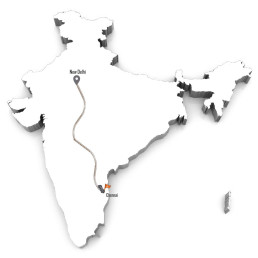
Jnana Yajna 8

Year & Dates:
December 16, 1954 to January 25, 1955

Yajna Topics:
Taittiriya Upanishad

Place:
Chennai, India.
It was an exhilarating, energetic unfoldment for 41 days in Thyagarayanagar, Chennai (Madras). The huge Pandal (enclosure) could not hold the teeming crowds; more than a thousand of the nearly 4000 people would stand for close to two hours engrossed in the inexpressible bliss of the melodic Taittiriya Upanishad. As Pujya Gurudev Swami Chinmayananda explained about the different kinds of Upasana in the first section of the Upanishad, the listeners were inspired. He also highlighted the ancient, convocation address of 25 key instructions given to students in Section 11 of Shikshavalli, pointing out that they were “Vedanta in Practice.” Those sacred commandments began with the teacher’s reminder, “Satyam Vada ” and pointed to how one can live a noble, integrated life.
Deeper Study, Increasing Crowds
Having prepared the audience to lift themselves to a higher vision of life, Pujya Gurudev guided them into the sublime, direct definition of Truth as “Satyam, Jnanam, Anantam.” Sharing the depth of the second section, “Brahmananda Valli,” He also challenged seekers to journey within and enquire intensely. Pujya Gurudev’s systematic, scientific analysis of the five sheaths (Panchakosa) within the human personality was gripping. The way He described the ascending scale of joy in the evolution toward the Absolute amazed the audience. The immortal discussion between Varuna, the Teacher, and Bhrigu, the Disciple outlining the steps to enquire and realize the Highest goal of life was embedded in the minds of the attentive audience. The thirst to realize that “The Source of all joy in the entire universe is but the Bliss of the Self ” was created in that momentous yajna. The earnest seekers who had already begun devoted study of the Upanishads after Pujya Gurudev’s second yajna in Chennai were further motivated to learn, analyze, and apply the scriptural teachings. The phenomenon called Chinmaya Study Groups would soon spread around the country and later the world.
In Admiration
Smt. Meenambal of Chennai vividly captures the transformative voyage guided by Pujya Gurudev Swamiji Chinmayananda, steering her weather-beaten vessel through life’s stormy ocean. “At first it was his learned exposition couched in the finest poetry that drew me to him. The fatigue of the day’s work or the distance that had to be walked or the rains could not stop me. I was drawn by some irresistible force, as it were. I felt I has at last landed on a sequestered harbour. What the temples, the Bhajans and the discourses failed to give me, the lucid explanations of the Upanishad by Chinmaya gave me. The mysteries of the grand universe, of which this little “I” forms a part, were slowly unravelled by my Guru, who, by his inimitable examples, made easy the most un-understandable portions of our Hindu philosophy.”
Photo Gallery

“Think,” Says Pujya Gurudev
All Upanishads start with a ‘peace invocation’, a prayer to the Cosmic Powers to ward off all obstacles on the path of study, and this prayer id daily chanted together by the teacher and the taught. A prayer is an invocation, and not a contract. Now-a-days, we are misusing this technique of prayer in our own ignorance and therefore we find that our Gods are deaf to our prayers. This is true today with all religions. The science of prayer explains, that when an individual surrenders himself-meaning, all his identifications with his body, mind and intellect-through devotion, reverence and understanding-love, he removes from himself all the causes for his limitations and what is thus left over is the Absolute perfection which is the essence of his very being. Thus, prayer is the active part of the divine action, while the final successful invocation is its fulfilment.
Taittiriya Upanishad Book, p. 8
In the definition of this bliss the scripture also gives us indirectly the conditions necessary for true material enjoyment. Wealth in itself is no joy unless the rich man is young enough. Mere youthfulness dissipates itself in wealth unless he is well-educated to live the healthy values of life. Mere knowledge and youthfulness cannot contribute to the enjoyment of the wealth unless he is well-disciplined and has developed sufficiently his willpower. One who has youthfulness, education, discipline, and power of self-control and self-assertion, if he is strong in body, mind and intellect, he alone is capable of enjoying wealth. To all others wealth is an added burden weighing down their shoulders. A donkey carrying golden bricks is in no way better and luckier than the donkey which is carrying mudbricks! The Prarabdha of the pigs cannot be improved because they are housed in Prime Minister’s own drawing-room.
Taittiriya Upanishad Vol. 1, No. 4 Yajna Prasad, p. 168
Curious About Fearless Wisdom?
Beyond ordinary joy lies the profound experience of Ananda Brahman. In this enlightening discourse from Taittiriya Upanishad, witness how the Vidvan, the true knower, conquers fears and transcends regrets, unveiling a life of eternal bliss. Dive into the culmination of the Upanishad with us, exploring the timeless wisdom that leads to self-realization. The excerpt presented here is an audio except from Taiittiriya Upanishad discourses given in Chennai, 1963.
Jnana Yajna 7
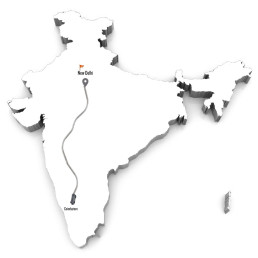
Jnana Yajna 7

Year & Dates:
September 26, 1954 to November 26, 1954

Yajna Topics:
Kathopanishad

Place:
New Delhi, India.
A warm welcome in New Delhi signaled a happy start to Pujya Gurudev Swami Chinmayananda’s seventh Jnana Yajna. The pace during the 61-day discourse series was brisk. Keeping with His unique style of introducing the main Upanishad with a series of preliminary talks, Pujya Gurudev spoke about the “Scientists of Life,” the rishis who studied and analyzed life exhaustively. Particularly in that age of reason over tradition, His preliminary talks gathered the attention of all who went from being simply curious to very committed. His evening discourses on Kathopanishad brought to life the thought-provoking discussion between the young seeker Nachiketa and the God of Death, Dharmaraja, inspiring not just Hindus but also people of varied faiths.
From Preliminary to Profound
It was during the 7th yajna that All India Radio recorded His talks on Religion & Life, Taming the Mind, and Mental Rehabilitation. Pujya Gurudev also taught Vivekachoodamani, Adi Shankara’s great text, during the morning 6:30 to 8:30 am discourses; the book manuscript of His famous commentary was close to being published. The Akanda Kirtan from October 26 to Nov.14, 1954, the Mrtyunjaya Havana from November 9 -14 with an hour’s chanting of the Tryambaka mantra from 8-9 am, and a six day Japa from November 15 – all these infused strength and enthusiasm in hundreds of people. On November 27th, after the Kathopanishad yajna concluded, Pujya Gurudev was invited to bhiksha at the President of India’s Rashtrapati Bhavan. Completing an immersion ceremony of the sacred ashes from the Havana Kund in the waters of Ganga, Haridwar, Pujya Gurudev marched southward, promising Delhi that more would come!
In Admiration
Mobasser, a Jew, while exploring Indian culture and Hinduism, found it initially confusing. He observed a Swami’s English discourses on Kathopanishad happening in Parliament Street, and soon found the jig-saw puzzle of Hinduism come together. He says “Swamiji gave me what I was seeking all round the globe. His universality charmed me; his scientific approach held me spell-bound; his grasp of details filled my hunger to know Hinduism. I discovered in Vedanta the Spirit of Persia. My own Persian Literature became a live-philosophy to me!”
Another devotee Susheela Sharma who considers herself fortunate to have attended the Kathopanishad discourses reminisces, “Gurudev was like the hawker, with utmost patience, brought out mysteries from the basket of KATHA that each evening was an event more thrilling than the movies! It did me good; I got what I wanted right at my doors.
If not for the “Door Delivery”, I would have been completely ignorant of my own Religion like thousands of others. Thank you Swamiji!
Photo Gallery

“Think,” Says Pujya Gurudev
This spirit of sacrifice and capacity to find within oneself enough sympathy to serve not only one’s own near and dear relatives but also the whole universe and thus put their Kalyan first, even before one’s own redemption, is one of the most important qualifications unavoidable in a true seeker, if he is to be a total success in his pilgrimage to Truth.
Kathopanishad Vol.1, part 2 p.55
“creation is a motion, a vibration of energy” and that it is possible for the vibration to maintain itself only if there be a motionless and nonvibrating medium, the Absolute Reality. Constant change can certainly give us the delusion of a form ; only there must be a constant medium, for the changes to play in or at least a constant axis upon which they can play. Thus, when a lit up Joss-stick (aggarbati) is rotated fast round the same axis we can detect the joss-stick maintaining itself in the form of a golden circle. The golden circle has no existence except in the consistency of change at the brilliant tip. Similarly, constant vibration of energy in a medium of Absolute Energy, and maintaining itself within the field of a constant axis gives us that ocean of sense objects made up of things and beings.
Kathopanishad Vol.1, part 6 p. 349
Sacred Duties of a Spiritual Seeker
Delve into the spiritual trinity of duties – scripture study, charitable actions, and knowledge-sharing – as we explore the holistic path of a spiritual aspirant. Uncover the profound impact of these duties on spiritual unfoldment, transcending material desires. Watch this striking snippet from Kathopanishad talk series by Pujya Gurudev Swami Chinmayananda given in Toronto, Canada in 1982.
Jnana Yajna 6

Jnana Yajna 6

Year & Dates:
May 9, 1954 to May 30, 1954

Yajna Topic:
Kenopanishad

Place:
Coimbatore, India.
Pujya Gurudev Swami Chinmayananda’s skilful use of English, a foreign language, to unravel the glory of the ancient Vedic scriptures was his singular contribution. An important colonial legacy that the British left behind was redefined as a unifying medium of a Vedantic awakening across India. Using his command of English to clarify and instill the essence of the ancient Upanishadic revelations from the very first yajna, Pujya Gurudev spearheaded a remarkable revolution.
As in the previous five yajnas, Pujya Gurudev Swami Chinmayananda did not hesitate to reach out and draw in the English-educated doubters as well as eager seekers to His 21-day discourse series on Kenopanishad in Coimbatore.
English for Enlightenment
Those who, with an anglicized outlook, had thought that the scriptures were irrelevant and incomprehensible were fascinated with Pujya Gurudev’s mastery over both the language and the subject of Vedanta. The audience did not need to know Sanskrit. Every word in Sanskrit was transliterated, translated, and explained in clear English from his very first yajna in Pune. Often, Pujya Gurudev’s expressions were poetic and painted a graphic picture. While indicating how the Infinite Brahman is inexplicable, Pujya Gurudev said: “We cannot produce the war of rolling thunders through the frail melodies of a flute!! Similarly, words cannot represent or express fully the roaring silence of all-full-nothingness, Pure Consciousness. In their attempts at reaching the Absolute, words pant and fall back as it were!” Throughout the Kenopanishad discourses in Coimbatore, while the vast audience marveled at Pujya Gurudev’s proficiency in English, they also recognized how His teaching went beyond the realm of language.
In Admiration
Recalling the profound influence of the discourses in Coimbatore, Shri R Venkataswamy Naidu of Coimbatore expresses how they served as nourishment for the intellect of all. “For me it was love at first sight. There was a void before and the lectures filled up the void. The scientific nature of our religion was pointed out and Chinmaya showed how the other religions cannot stand the test of modern scientific research. Hinduism, the revered old channel, sans eyes and sans teeth and sans everything, was presented to us as a young maiden of sixteen, smiling, dancing and full of life.”
Photo Gallery

“Think,” Says Pujya Gurudev
Mere book knowledge will not help in fulfilling the Indian philosophy. Unlike the philosophies of the West, to us the Indians a mere academic understanding of an intellectual view of life is not philosophy. To the Indian mind philosophy is at once a view of life and a way of life. A philosopher to us is not a mere idle-dreamer or an intellect-spinner but a hard and factual man of life who should show us also a certain value of life and how best his philosophy can be lived and realised. It is very significant in this connection to note that the word philosophy is in Sanskrit termed as “Darshanam” emphasis being in the availability of those ideas for realisation in the given life.
From Kenopanishad Yajna Prasad, p. 170
The student feels confused and confounded, Thus, to solve this Great Grand Riddle of Life, he approaches his Guru enquiring if there is an independent Eternal “director” who, by his mere “Wish” prompts the mind to alight on the objects? If there be such a a great Illuminator and Controller who is he? What is it? What is my relationship with the Supreme power Divine existing ever so secretively within me, ever vigilant, ever brilliant, ever alert?
It is now the function of the Upanishad to point out this realizable Truth that there is such a Divine Spark in us, which is Eternal Wisdom, the Atman.
From Kenopanishad Yajna Prasad, p. 94
Questioning the Unquestionable
Dive into the mysteries of scriptural texts as we unravel the contemplative style that seeks to express the inexpressible. Discover the efficiency and beauty embedded in the sacred scriptures of the world. Watch this powerful snippet from Kenopanishad talks given at Houston, TX, USA in 1981.
Jnana Yajna 5
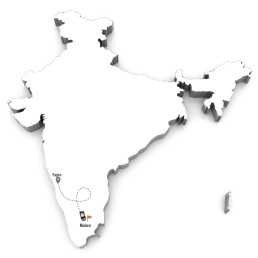
Jnana Yajna 5

Year & Dates:
February 14, 1954 to March 26, 1954

Yajna Topic:
Prashnopanishad

Place:
Madurai, India.
In the sacred town of Goddess Meenakshi and Lord Sundareshwara, Pujya Gurudev Swami Chinmayananda expounded on Prashnopanishad every evening during his 41-day, fifth Jnana Yagna. His discourses painted a striking picture of the six advanced disciples approaching Sage Pippalaada with their philosophical questions about creation, worship, sadhana, the realms of dream and deep sleep, and the seat of the Eternal Self. However, His eloquence was not just with His words. Ending every session with twenty minutes of meditation, His teaching of the powerful impact of Silence was what stunned most of the 2300-strong audience everyday.
The Magic of Meditation
As much as the audience was captivated by His incredibly rational, scientific explanations, they were enthralled by the way Pujya Gurudev would carry the thousands in the crowd as one to the heights of silence. Being a Master Teacher, He was aware that the modern minds were too hurried and fragmented to latch onto the evolved thought patterns in any Upanishad. So, the aspect of meditation that He had mindfully incorporated from His first yajna provided the perfect base; it encouraged seekers and showed how the abstract spirit of Vedantic learning could be imbibed practically. In the silence of meditation, the potent teachings of the Upanishad became greatly amplified. The ardent seekers of Madurai who had tasted the sweet silence strived to practice meditation regularly after that fifth yajna.
In Admiration
Mrs. Kamala from Madurai beautifully encapsulates the core of her experience attending Pujya Gurudev Swami Chinmayananda’s Yajnas: Swamiji’s Yajnas can be otherwise termed as “Vedanta Made Easy.” It is not only easily understandable, but also convincing. The practice of meditation at the end of the daily discourses is the practical experiment, after the exposition of the theory earlier, which goes a very long way to help the seekers in their endeavour to realize what life in reality is. It is impossible to discontinue the practice of sitting up for a few minutes of meditation, after undergoing the rigourous training every evening under Swamiji’s direction. It certainly helps one to develop the proper attitude towards life as such, and greet its apparent miseries with a smile.
If one attends Swamiji’s Yajna with utmost sincerity, understands the discourses properly and practises regularly, one will, without the least hesitation, admit that “The Yajna Acts.”
Photo Gallery

“Think,” Says Pujya Gurudev
This spiritual experience, the story here (in Prashnopanishad) clearly indicates the importance of austerity, brahmacharya and faith. Austerity redeems the personality in the seeker from its inertia; brahmacharya relieves his psychological and intellectual debilities; and faith sharpens his intensity and sincerity in meditation. Without these three, life on the spiritual path cannot ever be graced with full and easy success.
From Prashnopanishad Book, p. 34
With egocentric misconceptions about himself, as the ego observes a world, the ego must necessarily seek to know how it has been created. Here, the intellect is trying to know how the mind is living upon its own perceptions. It is something like the tooth wheels in the rollers of the cinematograph wondering and enquiring how the film is moving! The movement; if the film is but their own movement; if the wheels stop, the film also must stop.
From Prashnopanishad Book, p. 41
God is the world of Plurality
Unveil the intricate relationship between food, prana, and God. Understand the profound simplicity that lies within the analysis of creation and its connection to our own spiritual purity. Watch this excerpt from Prashnopanishad of Gurudev from Mumbai 1987
Jnana Yajna 4

Jnana Yajna 4

Year & Dates:
January 7, 1954 to January 27, 1954

Yajna Topics:
Ishavasya Upanishad

Place:
Palakkad, India.
From the cosmopolitan setting of Delhi to the conservative, diffident crowd in Palghat, the revival was on the move. A Vedantic wildfire was ignited by Pujya Gurudev Swami Chinmayananda across diverse audiences. He wanted the all-pervasive Knowledge to reach the maximum without any bias. In His preliminary talks before He introduced Isavasyopanishad to the Palghat public, He challenged: “I want neither your faith in nor your devotion for the ancient scriptures to be brought into this Yagnasala to stultify or color your poor discrimination; bundle them away! Come here with a sharp and pointed intelligence; thirsty to know and willing to strive.”
Scientific and Vivid Logic
To the many who looked upon Hinduism as an orthodox bundle of rituals and superstitions, His approach of uncompromising and scientific logic enhanced by familiar life examples was first intriguing and then became deeply interesting.
In the vibrant 21-day yajna at Palghat, Pujya Gurudev carried the audience of Palghat on an exciting voyage as He described and explained the five ‘waves of thought’ in Isavasyopanishad. The first tall wave of the ‘Route to Renunciation’ that the rishis extolled was followed by the second sincere wave of the ‘Path of Action.’ The vivid portrayal of the highest goal of life was the third, transcendental wave. Knowledge reinforced by devoted action would yield maximum dividend, emphasized the fourth wave. The fifth, final wave of thought was the triumphant transition from mortal manhood to immortal Godhood!
The different elements of His Jnana Yajna left an unforgettable impression in the minds of the Palghat people who dived into Self-Awareness, worshiped together in the concluding Havan (Homa), and were inspired to seek and recognize the Omnipresent Divine in everything around!
In Admiration
Shri A S Menon from Palakkad remembers his first memories of Pujya Gurudev Swami Chinmayananda, “The striking feature in Swami Chinmayananda that has charmed me is the scintillating expression of joy in his face – a face which is impervious, to an astonishing degree, to attacks of despondency and gloom. Not that situations which would give rise such feelings were lacking in Swamiji’s life.”
Photo Gallery

“Think,” Says Pujya Gurudev
The Gyana Yagna is thus a movement of renaissance rather than an attempt at creating a sect of compromisers trying to build up a limited cocoon to bury themselves in! We shall in the first three days go into these general definitions, which are absolutely necessary in understanding the chosen text, and thereafter plunge ourselves into the main textbook itself: The Ishavasya Upanishad
From Ishavasya Upanishad Book, p. 16
I am sure that I have now made it amply clear how far our enquiry would be interesting and fruitful, not only to ourselves but to the world at large, in case we undertake this work in a pure spirit of research and scholarship. I want neither your faith in nor your devotion for the ancient scriptures to be brought into this Yagnasala to stultify or colour your poor discrimination; bundle them away! Come here with a sharp and pointed intelligence; thirsty to know and willing to strive.
OM TAT SAT
From Ishavasya Upanishad Book, p.21
Upanishadic Teachings on the Ineffable
Explore the enigmatic world of the Upanishads, where the sages use language not to define but to point towards the indescribable Reality. Immerse yourself in the subtlety of their expression, guiding your mind into a contemplative state that transcends conventional understanding. An excerpt from Ishavasya Upanishad talk series at Berhampur in 1983.
108 Jnana Yajnas
What Pujya Gurudev Swami Chinmayananda called an afternoon dream became a mighty call and then grew strong as the “Gangotri Plan – the Ganga Scheme.” Like the holy Ganga who flowed from the pristine peaks of the Himalayas to share her abundance with the plains, Pujya Gurudev came down from Uttarkashi with overflowing compassion to share the ancient scriptural wisdom and chart a Vedantic road map to spirituality. The journey that He undertook since His first Jnana Yajna in 1951 at Poona transformed generations across the world to become an endless flow of Knowledge. From 1951 to 1993, in 532 glowing Jnana Yajnas, Pujya Gurudev transformed countless lives.
As we prepare to celebrate Pujya Gurudev Swami Chinmayananda’s 108th Janma Jayanti on May 8, 2024, Chinmaya Archives invites you to a phenomenal pilgrimage into the past where we retrace the first 108 sacred steps that became a mighty movement called Chinmaya Mission. Hari Om!
Jnana Yajna 3

Jnana Yajna 3

Year & Dates:
September 12, 1953 to December 10, 1953

Yajna Topic:
Mandukya Upanishad

Place:
Karol Bagh, New Delhi, India.
An impactful metamorphosis inside a bustling metropolis – in the 91 days after an orange ‘sannyas’ flag bearing the all-encompassing Om symbol was unfurled in the yajnashala at Karol Bagh, New Delhi, the transformation was striking. The educated elite, the agnostics, atheists, the seekers, the people of other faiths and the staunchly-faithful sat as one, spellbound. How could an Upanishad, that too the shortest with twelve verses, reconfigure their entire outlook? But Mandukya Upanishad and Gaudapada Karika as expounded by Pujya Gurudev Swami Chinmayananda took the most fortunate in Delhi to heights of profound silence. The discourses immersed them in the inmost experience of the all-pervasive Om. Even His Guru, Swami Tapovanam, was overjoyed that a materialistic city had halted in meditation on the Highest Truth.
A Spiritual Toolkit for Sadhana
The third Jnana Yajna revealed not only the direct path to the Supreme Essence but also empowered seekers with practices of Sadhana. The features which Pujya Gurudev had included in His Jnana Yajna from the very beginning were becoming an unforgettable part of a collective spiritual journey. The Akanda Kirtan and chanting of the Mahamantra, “Hare Rama Hare Rama, Rama Rama Hare Hare; Hare Krishna Hare Krishna, Krishna Krishna Hare Hare,” kept echoing across Delhi. When even children participated in a 11-day Kirtan, when all the audience did an Akanda Japa of “ Hari Om,” and when everyone completed a Likhita Japa (a written Japa) during the end of the third Upanishad Yajna, the power of constant remembrance in the path of purity was understood. When Swamiji revealed the meaning behind Deepavali and Navaratri during the celebrations during this Jnana Yajna, devotion added a special glow. When the devotees’ sacred immersion in the holy waters of Yamuna was complete, it was beautifully clear that the core of Hinduism was being revitalized in that milestone Yajna.
In Admiration
Rahila Ansari, a Muslim introduced to the luminous wisdom of Pujya Gurudev Swami Chinmayananda through a dear friend, eloquently reveals the profound impact these discourses had on her. In her own words, she gracefully confesses, “I went to the lectures partly out of curiosity, but mainly to please and humour my friend. But imagine my bafflement, it did not take me long to feel that I had a right to me there. There was hardly any talk of God, but Godliness prevailed. Hinduism as expounded by Swamiji was not a religion based on old wives tales, but on a practical and highly developed code of morality. Swamiji’s lectures have certainly enlarged my views, destroyed my prejudices and brought me to a pinnacle from which I can see all human beings equally blessed! I am grateful to Him for this!”
Photo Gallery
Yajna Prasad: An Instrument to nourish our core
The Yajna Prasad booklet, distributed weekly to seekers during the Yajna, carried a resolute message from Pujya Gurudev. It underscored his unwavering commitment to serve and remain connected with all earnest seekers. It states “Swami Chinmayananda is always at the service of all sincere seekers and all are welcome to him. You can open at any time free correspondence with the Swami. Clear all doubts; what remains then is Knowledge supreme.”

“Think,” Says Pujya Gurudev!
Although only a few of us complain against the ‘wandering mind’ almost all of us are conscious of the mind. Yet, very rarely, if at all, does any one of us definitely know what the mind is. Unless we know what the mind is, it must certainly be difficult to control it. This ignorance is mainly the cause of all failures of Truth-seekers in spite of their diligent practice.
From Mandukya Upanishad Yajna Prasad Vol. 2, p. 42
“All that is past, present and future is, verily, OM.” All that was, that is, and that shall be, meaning the entire world of objects cognized by our forefathers, by our forefathers, by ourselves and by our children, …the entire world has but one substratum, which is unchanging in all the three periods of time, and it is represented by the symbol and name “OM”.
Here also it may be possible that the student may fall in to another misunderstanding that the world, conditioned by time alone has “OM” as its substratum and that it is not the ground for the world of experiences that are beyond the concepts of time, space and causality. Thus, the Master clearly emphasises here that “OM” is a substratum for all that is limited in time and also for all that is not conditioned by it, meaning that which is even beyond the triple concepts of time.
The concept of time is a trick of the mind. Where there is no mind, this concept of time also does not function. But we all know that mind is in itself matter, inert and insentient. When the mind is in conjunction with life; it gains a similitude of activity in its sentience and conscience. Thus, that, which is beyond time, is the very Divine Spark of life, because of which, this assemblage of body mind and intellect functions as though it is a vibrant and dynamic being.
Thus, “OM” represents in its symbolism, as well as in its syllabic-significances, not only the manifest world of plurality, but also its substratum, the unmanifest, Non-dual Reality.
From Mandukya Upanishad Yajna Prasad Vol. 5, p. 34
Understand the essence of Om
Let’s revisit the Yajna on Mandukya Upanishad in New Delhi, juxtaposed with a subsequent discourse delivered at Sidhbari in 1991 with this short excerpt.
Unravel the transformative power of “Om” and its role in expanding consciousness. Discover how the teacher becomes an empty reed, allowing the divine to express through, and how the declaration that everything is Brahman transcends time and form.
